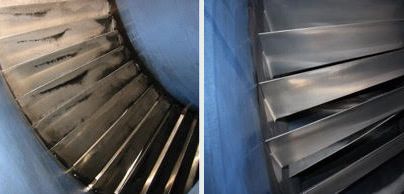GT AIR FILTRATION
THREE MAJOR PROPERTIES DIFFER FROM ONE FILTER TO ANOTHER.
THE TECHNOLOGY USED IMPACTS UPTIME AND OPERATING COSTS
BY MIKE ROESNER

Caption: Inlet guide vanes (left) after 1,200 hours of low-efficiency filtration and the same components (right) after 5,000 hours of high-efficiency filtration
At an outdoor gas turbine (GT) plant, inlet air must be clean and dry as it mixes with fuel to produce power. Airborne dirt and contaminants can hamper power output, drive up fuel costs and potentially damage critical components.
According to the U.S. Environmental Protection Agency, around 1,300 pounds of particulate could still enter a GT housing and inlet air filter in a year of operation. Each facility has different filtration needs based on variables such as: Local environment: Is the plant in a humid or ocean-front location, a desert, agricultural, or arctic environment and is it subject to severe weather events?
Operating demands: Is the facility a peaking plant or does it operate continuously, or power a mechanical drive?
Inlet design: Does the system automatically pulse-clean the filters with compressed air during operation or does it operate as a static system?
There are also three primary filter characteristics that contribute to optimal GT operation for pulse filter housings: efficiency, water-tightness and pulse recovery rate. Since filter media are engineered for specific conditions, variations exist that make certain filters more suited to given environments. Plants in some geographies demand all three characteristics; some, just one or two. Those charged with filter selection, therefore, can use these characteristics to only pay for the filtration characteristics that are required.
Efficiency
Efficiency refers to the proportion of inlet air particulates the filter removes, measured by particle concentration upstream and downstream of the filter. This is the most widely recognized filter trait, and until recently, the only one with consistent testing standards. The cleaner air produced by higher filtration efficiency produces better combustion, sustained power output and longer lasting turbine blades.
A low-efficiency filter used for 1,500 hours, for example, allows significantly more fouling than a high-efficiency filter used for 8,000 hours. Of course, there are cost trade-offs to consider. Lower-efficiency filters have a low initial price tag. However, they can sometimes require on- and off-line water washings to periodically regain some of the power output loss due to fouling.
High-efficiency particulate air (HEPA) filters cost more initially but stabilize power output due to increased compressor health. Due to being more restrictive, though, the turbine will put out slightly less initial power than a comparable lower-efficiency filter that offers a lower initial pressure drop. It is a case of balancing these factors to determine the right choice, i.e., does the stabilized power output of HEPA filtration offset the decrease in output due to efficiency loss in lower-efficiency elements.
Water-tightness
How well a filter stops water or how it performs in a wet condition may outrank efficiency as a priority for some operators. In humid or ocean-front locations, salts and other dissolved solids carried by water can be highly corrosive, often even more detrimental than airborne contaminants. GT manufacturers usually recommend that less than 0.01 parts per million (ppm) of salt enter the system. In coastal environments, airborne salt can easily range from 0.05 to 0.5 ppm on a typical day. This is more than 10 times the chloride concentrations of inland areas.
A good way to test water-tightness is to direct a 60-liter-per-hour water spray at the filter over an eight-hour period. The filter pressure drop and volume of water passing through the filter are recorded. The best-performing filters survive the test with at least 99.5% water stoppage and no more than a 2-inch water-gauge (WG) increase in pressure drop across the filter during this test.
Pulse recovery rate
When dust builds up on filters, the resulting drop in airflow compromises power output. As an option, some inlet housings have a self-cleaning mechanism incorporated into their design. In these systems, compressed air pulses dislodge dust while the system operates. Pulse recovery rate measures how cleanable air filters are in such systems, i.e., how often they can be pulsed and how quickly they return to a like-new condition.
A filter with a high pulse recovery rate sheds dust more easily and restores optimal airflow faster. Fast pulse recovery is a high priority in deserts, high-dirt load or Arctic environments where there is continual exposure to dust, snow, ice or the potential for sudden episodes of heavy loading, such as sandstorms. Some operators turn on their pulsing systems prior to severe weather events to prevent fouling.
As with efficiency and water-tightness, pulse recovery can be rated using laboratory test data. After exposing filters to simulated high-dust conditions for a long duration, pressure-drop and efficiency can be measured. The construction of filter media determines cleanability. Surface-loading filters trap particles on the top media layer where they form a slight dust cake that is easily pulse-cleaned. Depth-loading filters, by contrast, have media layers that trap progressively smaller particles and thus cannot be readily cleaned.
For those with a static system, it is advisable to specify filters with good dust-holding capacity. Back this up by monitoring pressure drop and turbine performance. Change the filters when pressure loss exceeds an acceptable limit, as there is no way to recover a static element.
Knowledge of these three properties can help operators periodically evaluate plant filtration needs. It may become necessary to convert to a more optimal filter if the environment or operating conditions change. If a rock quarry re-opens near a GT plant and creates dirtier air, for example, a plant with a pulsing system might consider converting to filters with better pulse recovery. Alternatively, if a coastal peaking plant switches to base-load operation, the owner may want to upgrade to filters with higher efficiency and better water-tightness.
Mike Roesner is Aftermarket Manager of the Gas Turbine Systems division of Donaldson Company. All photos
courtesy of Donaldson. For more information, go to go.donaldson.com/gas-turbine-systems/ or call 800-431-0555.